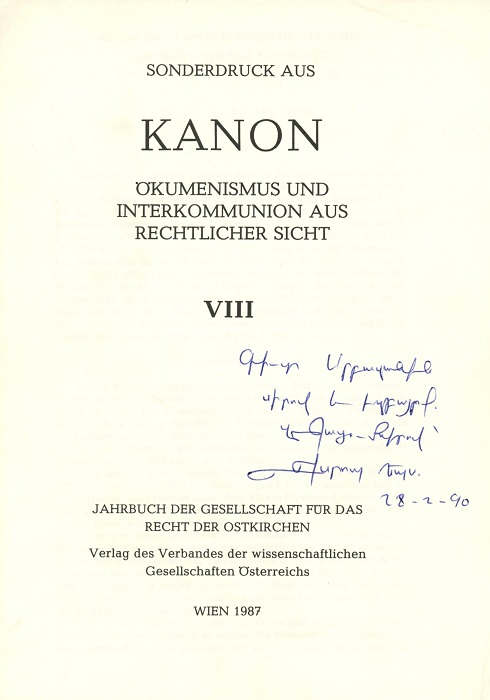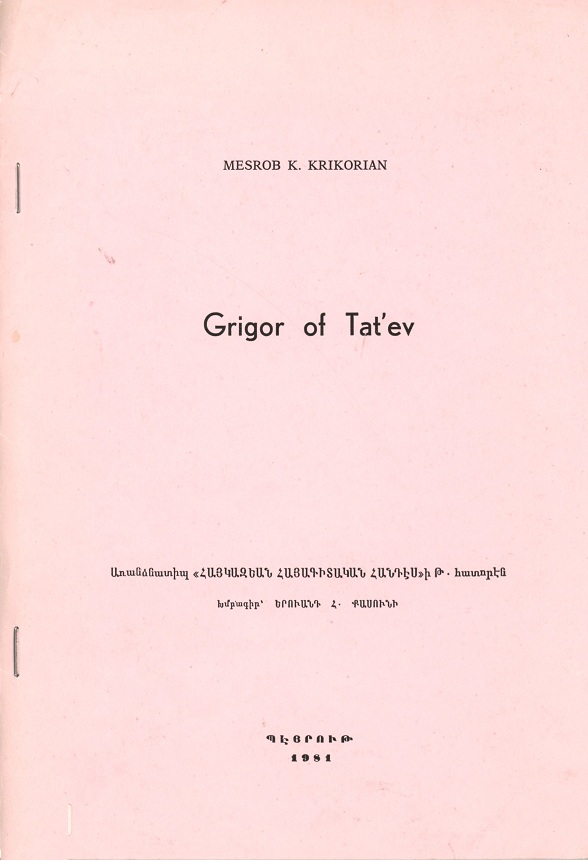
335 Rangement général
 | | Recent encounters between the churches and their canonical significance: an oriental-orthodox point of view |
| Titre : | Recent encounters between the churches and their canonical significance: an oriental-orthodox point of view / auteur(s) : Mesrob K. KRIKORIAN - |
|---|
| Editeur : | Verlag des Verbandes der wissenschaftlichen Gesellschaften Usterreichs |
|---|
| Année : | 1987 |
|---|
| Imprimeur/Fabricant : | Wien |
|---|
| Description : | 17,5 x 24 cm, pp. 105-117 |
|---|
| Collection : | |
|---|
| Notes : | Extract of Kanon : Oekumenismus und Interkommunion aus rechtlicher Sicht - VIII |
|---|
| Autres auteurs : | |
|---|
| Sujets : | Ecumenism |
|---|
| ISBN : | |
|---|
| Lecture On-line : | non disponible |
|---|
Commentaire :Introductory remarksThe scope of the present study is to describe and analyse recent encounters between the Oriental Orthodox Churches and the Church of Rome and to evaluate the consequent implications of the declarations. In my investigation I have not amply included the Eastern Orthodox Churches, because after the unofficial ecumenical consultations of Aarhus, Denmark (August ll'^-lS"1, 1964), Bristol, England (July 25th-29'h, 1967), Geneva, Switzerland (August 16th-21", 1970) and of Addis Abeba, Ethiopia (January 22"a-23M, 1971), no further steps were taken, whereas after the Second Vatican Council (December 25th, 1961 - December 8"1, 1965), official and very important meetings have occured between the Primate of Rome and the Heads of Oriental Orthodox Churches. Apart from the patriarchs, also individual bishops and special delegations have paid visits to Rome, and reciprocally Roman Catholic delegates have visited centres of Oriental Orthodox Churches. Understandably I am going to sum up only the encounters which have taken place on high level, mostly in Rome. |
122 Rangement général
 | | Grigor of Tat'ev |
| Titre : | Grigor of Tat'ev / auteur(s) : Mesrob K. KRIKORIAN - Extrait de Haigazian armenological review |
|---|
| Editeur : | Haygazian |
|---|
| Année : | 1981 |
|---|
| Imprimeur/Fabricant : | Beirut |
|---|
| Description : | 17 x 24,5 cm, 8 pages |
|---|
| Collection : | |
|---|
| Notes : | |
|---|
| Autres auteurs : | |
|---|
| Sujets : | Armenian Church -- Grigor of Tat'ev |
|---|
| ISBN : | |
|---|
| Lecture On-line : | non disponible |
|---|
Commentaire :INTRODUCTIONVardapet Grigor Tat'evatsi (of Tat'ev) has been a dominating figure in XIV-XVth century church history of Armenia. As a theologian and teacher he achieved so much that he influenced even the events and orientation of the Armenian Church in the following centuries. His pupils and later Armenian authors generously and of course rightly call him «the great Vardapet» (teacher), «heavenly champion», «the brilliant torch of Tat'ev», «eternally shining sun», «a source propagating the teachings of Christ», «Second Enlightener» (the first being Grigor the Parthev, the first official Patriarch of Armenia), «Second John Chrysostom» etc.
The second half of XlVth century was a very difficult time for the Armenians. The Mongol-Tartar hordes, under the leadership of Timur Lang (1336-1405) were raiding, plundering and destroying Greater Armenia, whereas the Mamelukes of Egypt were continuously attacking Little or Cilician Armenia which finally lost its independence in 1375. The Armenian Church also was suffering due to internal and external conflicts and struggles: the local Patriarchal See of Aght'amar near Lake Van (the present Ahtamar in Turkey) had revolted against the Mother See whose center was still located at Sis, in Little Armenia. At the beginning of XlVth century, according to a missionary program, Rome endeavoured persistently to win the Orthodox Armenians and Syrians and to bring them under its authority. The Franciscan fathers preached and taught in Cilicia, Northern Armenia and Georgia, whereas the Dominicans laboured in Greater Armenia and Persia. The leaders of the Armenian Church were very disturbed about this challenging situation and sought a solution for the crisis. |
|